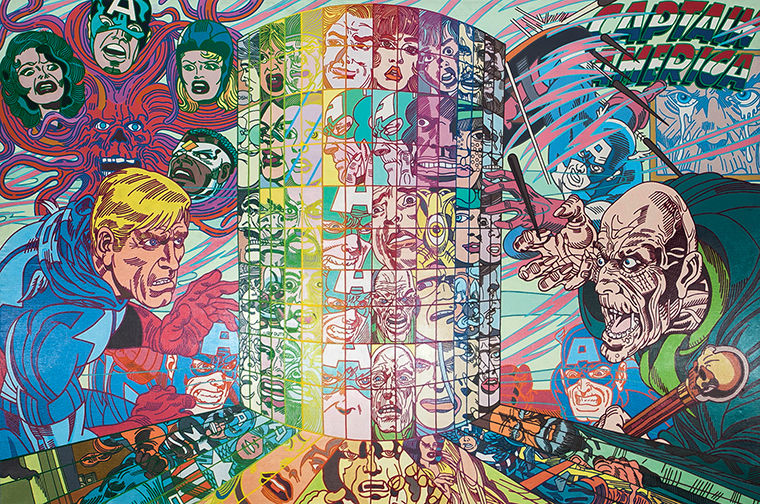Icelandic artist comments on American culture
Icelandic artist Erró creates collages using pop culture imagery and American comics. He projects the collages onto large-scale canvas and uses acrylic paints to replicate the images. This exhibit is Erró’s first show in Chicago.
February 9, 2015
Painted patchworks of colorful American comic book and pop culture excerpts are filling the walls of Mana Contemporary Chicago, an art center located at 2233 S. Throop St., until April 30.
The exhibition, “Erró: American Comics,” is traveling from Mana Contemporary headquarters in Jersey City, New Jersey, and is going to be presented courtesy of Galerie Ernst Hilger in Vienna, Austria. Selena Ricks, public relations director for the gallery, said the show is part of Mana’s international gallery collection program.
“We opened the Erró show [in Jersey City] in September,” Ricks said. “We decided to have the show travel to Chicago to expand the audience and to see a new network.”
Erró is a post-modern artist from Iceland who creates collages from American comics and pop culture imagery and projects the collages onto a canvas and paints them.
The exhibition will run through April 30 and showcases 11 works Erró created between 1979–2009. “Erró: American Comics” focuses on two dominant aspects in Erró’s work: superhero-themed narratives and his famous “Scapes” series. Through these two main themes, the exhibition commenys on society and culture in a manner similar to the many pop artists from the 60’s.
Austin St. Peter, an adjunct professor in Columbia’s English Department, said in an email that Erró has been creating art since 1958. The first piece he saw by Erró was “The Daughters of Mao,” which was part of a catalog during his Chinese cycle in the 1990s.
“I thought [the piece] represented a beautiful critique of authoritarianism—a critique that came by way of the careful juxtaposition of limited elements,” St. Peter said. “Erró contrasted a socialist realist-style portrait with a far more cartoonish, far less carefully rendered set of skeptical daughters.”
Ysabel Pinyol, curatorial director for Mana Contemporary, stated that pop culture imagery reflects his artistic belief that more is better, the email stated.
“[Erró’s work is] busy, but it’s busy on purpose,” Ricks said. “He’s really making a comment about American culture and mass consumption.”
Since the beginning of his career, Erró has continuously used his artwork to create a series of vital interventions, St. Peter said in the email.
“When Erró’s interventions are at their strongest, they come by way of his canny ability to use montage and juxtaposition,” St. Peter said. “[He uses these] to enable his collage and combination work to move beyond simply representing culture to making a second-order critique.”
Now at the age of 83, Erró has made a fundamental shift in terms of the physical size of his art pieces and through his appropriation strategies, St. Peter noted in an email.
“Erró’s earlier period works used juxtaposition to produce second-order criticisms of culture and observer, form and content, media and figurative representation, [and] conservative politics,” St. Peter’s email continued. “I’m concerned that Erró’s combination of French revolutionary spirit with an American pop art sensibility may have ceded the revolutionary Geist—leaving in its place the type of work that earlier period Erró would have critiqued.”
Ricks said when the exhibit was shown in Jersey City, it resonated with the college students that came to see the show because they connected and related to the pop culture imagery of Wonder Woman and other iconic superheroes that was shown.
“[I am hoping this exhibit] stirs some debate about the use of comics in art,” Ricks said. “I think for Erró, his statement is really about how American culture is spreading internationally to become a global culture and I think that’s an interesting statement [to make].”








